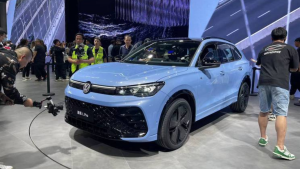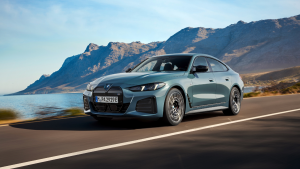Global destiny
Team OD
Updated: May 09, 2013, 04:11 PM IST
That Jaguar has succeeded post the buyout by Tata Motors is no secret. What makes the Jaguar success story even more interesting is that the current product line which includes the XK, XF and the most recently launched XJ was slated to turn the company fortunes even before it changed hands. That Jaguar wasn't bailed out by the British government and that Tata Motors stepped in, in time to throw this massive buoy was a pure meeting of destinies.
Part of Jaguar's success is attributed to the strong and dynamic product line that is already in place but growth is only going to come from what's in store for the future. That future has to have global products like never before and that was the message imparted at a two-day technical and design briefing at Jaguar's facilities at Whitley.
By global what Jaguar essentially means are products that are no longer unique or niche but are accessible and enticing to a much large customer base that is largely dominated by manufacturers such as Audi, BMW and Mercedes. That means smaller cars and engines, the first phase of which is the new 2.2-litre diesel that will be placed in the 2012 XF and which we got to sample briefly around Jaguar's facility at Whitley.
Designated the AJ-i4D (and the DW12C for the Range Rover Evoque), this particular engine is an evolution of an engine used by the Freelander, the PSA Group/Ford's DW12B common-rail turbodiesel. The evolution has improved NVH, efficiency and most important of all it's a longitudinal installation to cater to the XF's rear wheel drivetrain.
Engine output is a modest 190PS (by most Jaguar standards) though torque is a stupendous 450Nm. It's a fairly quick engine aiding the XF in attaining 100kmph in a claimed 8 seconds with a top speed of 220kmph. However of more import is the way this engine sounds and feels. Refinement is high up the order as is efficiency. Optimised low friction pistons and other low resistance internals take care of these aspects. In addition changes to the block, cylinder heads and crank further enhance the NVH solutions. Quieter fuel injectors, a water-cooled turbocharger and additional sound deadening materials inserted between the top of the engine and its covers further reduce the injector noise.
Certain components have also been re-engineered such as the double walled sump that contains a rubber layer and an internal honeycomb structure within the front timing cover. Even the turbocharger is water-cooled to effect the same noiseless and vibe free results.
The longitudinal installation of this engine is a first for a Jaguar. Since this engine is derived from the Freelander where it is installed transversely, changing the position to drive the rear wheel presented its own set of challenges. Several modifications had to be engineered to make it fit as well as newer components developed such as the oil pan, timing drive cover, heat shields, fuel lines and engine mounts to mate comfortably. Jaguar in the effort of packaging that engine bay optimally also managed shaving off some weight.
Overall one of the critical tasks of this engine is to provide optimum efficiency and the XF's claimed fuel efficiency of over 18kmpl is highly critical to it being accepted in diesel predominant markets. Efficiency from this engine however is not just a measure of how far it can stretch a litre of crude. Efficiency also comes from the new intelligent start/stop system which uses a slightly different method of operation. In most cars the engine cuts off when you come to a complete halt at a traffic light and restarts when you step on the throttle. But the XF's system allows you to ignite the engine the second you ease pressure off the brake pedal. All this happens without the engine slipping into neutral mode when limp, so drive is available instantly when you release the brake pedal. This does sound a bit risky, but a built-in fail safe ensures the car does not roll forward or backward until the throttle pedal is depressed. Jaguar claims that the system allows 40 per cent quicker launch acceleration than the competition which apparently is a significant enough demand in Europe.

Nonetheless within this system several loops have been inserted forming a complex network. Trying to drive this car with the start/stop function therefore needs a few lessons. For instance it has a Change of Mind (CoM) mode, so if you come to a traffic light, step on the brake and just as the engine is dying out the lights turn green, you simply lift your foot off the brake and the engine will not continue to kill itself but will instantly be ready to roll off.
All these operations incidentally occur within fractions of a second, so yes, the system is quick but according to me a bit cantankerous. Don't get me wrong - I do think start/stop is yet another leading solution to reducing an automobiles carbon footprint but what Jaguar showcased just isn't a simple to understand or operate solution. I for one don't appreciate having to stand at a traffic light with one foot on the brake all the time. If Jaguar had to insert an auto hold into the start/stop system it would have made things a lot simpler.
Yet another change for the model year 2012 XF is the 8-speed ZF automatic gearbox. The eight ratios are spaced out to provide strong acceleration in low gears while balancing relaxed high speed cruising as well as supporting fuel efficient characteristics. New lightweight construction and fewer gear sets (just four gear sets and five shift elements) ensure the weight of this gearbox and size are no more than the older 6-speed gearbox. This transmission is also integrated with the start/stop system and allows the gearbox to provide drive in less than 350 milliseconds when the engine restarts.
A lot depends on the success of this engine and while the XF is the first car to use this engine and transmission system, it certainly won't be the last. This engine however will not make its appearance in India immediately. What I drove and experienced is still a short distance away from being production ready. In India it will need to be homologated and tuned for Indian fuel conditions. One of the challenges is that Indian fuels can cause problems for diesel particulate filters and necessary modifications will have to be made. So at best expect to see this new engine in the XF by early 2012. But will it feature in the Freelander which will soon be assembled in India?
Well, if Land Rover offers the Freelander in 2WD option, I don't see why it shouldn't be an added benefit to the JLR line-up.
Related Stories
Top Stories
Latest Videos
Most Popular
- Budget Sportbike Showdown: Kawasaki Ninja 500 vs Aprilia RS 457 vs Yamaha YZF-R3
- 2014 Triumph Daytona 675 vs 2024 Kawasaki ZX6R - A Decade of Evolution in Supersport Motorcycles
- Mumbai-Pune Expressway speed restrictions updated
- Bajaj NS400 picture leaked ahead of its launch
- 2024 Bajaj Pulsar N160 launched at Rs 1.39 lakh; gets USD forks & new features
1
2
1
2
Network18 Updates
Compare










